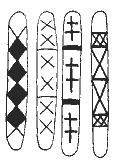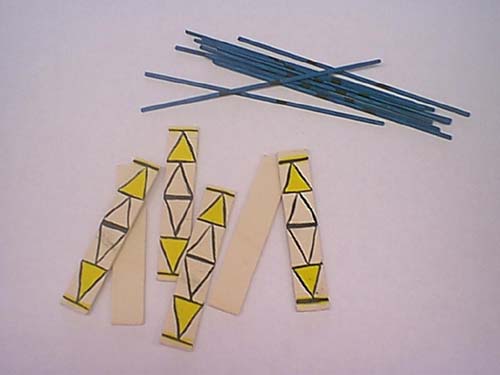| Origin: | Pomo Indians of California | ||||||||||||
| History: | The Pomo used finely polished beads for trade and created an elaborate numbering and arithmetic system -- base 20 and units of 400 -- to keep track of the value, which varied by diameter, and thickness. The Pomo nation is also well known for their intricate basket weaving techniques. Along with the beads, these baskets were used in trade both in and outside of their culture. Basket weaving patterns are used to create the varied designs used on the stick dice. | ||||||||||||
| Original Materials: | wood (burned etching) - dice; twigs - counting sticks | ||||||||||||
| Adapted Materials: | 6 tongue depressors or popsicle sticks - dice; 12 toothpicks - counting sticks | ||||||||||||
| Players: | 2 players or teams | ||||||||||||
| Setup: | Decorate one side of each of the 6 sticks with the same design. Here are some design ideas that people have used.
 | ||||||||||||
| To Play: | The players take turns tossing the stick dice onto the ground and keep score using the 12 counting sticks. | ||||||||||||
| To Score: | Different combinations will score different point values. At the start of the game, the counting sticks should be on a pile on the ground. The players collect sticks from the pile until it is used up, and then collect from each other. The first player to earn all 12 counting sticks is the winner.
| ||||||||||||
| Math Content: | Data management, probability, patterns and relations, numbers and operations. | ||||||||||||
| Source: | Carlson L. (1994). More Than Moccasins, Chicago Il: Chicago Review Press. | ||||||||||||
 |
 Return to Aboriginal Games | Return to Math Central |